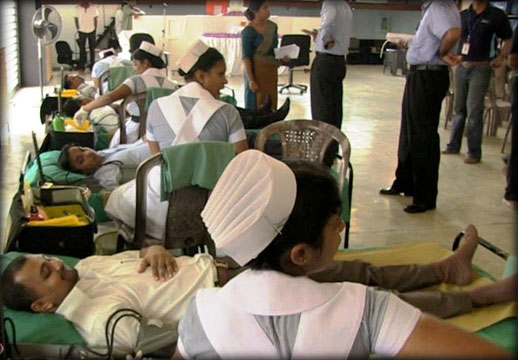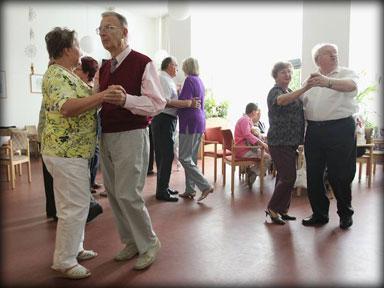|

Blood:
The life saving donation
By Carol Aloysius
Voluntary blood donations have become increasingly important today,
living as we are in a world where road accidents have soared to new
heights with victims requiring immediate transfusion support with
compatible blood that matches their blood group and pregnant women whose
very lives depend on whether or not they get the badly needed blood
transfusion during a specially complicated delivery. With the aim of
commemorating the humanitarian act of voluntary blood donors and
promoting the awareness on blood safety the WHO has declared June 14th
as the World Blood Donor Day, which is celebrated world over every year.
Blood donations have also assumed special significance in the light
of a surge in infectious diseases that could have serious impacts on the
recipient if the donor happened to be infected by an infectious disease,
such as HIV / AIDS or Hepatitis. To face this looming challenge the
Health Ministry is currently introducing new technologies to further
improve and strengthen the blood transfusion services in the country.
For its contribution in this field, the National Blood Transfusion
Services (NBTS) Sri Lanka recently won global recognition and was
awarded the Best Developing Country Award in 2012 .
In an interview with the Sunday Observer, Head of Quality
Management/NBTS, Dr Kumudu Kuruppu discusses strategies put in place for
ensuring safe blood and explains why this year's World Blood Donor day
campaign focuses on the theme of ' Saving mothers with Safe blood'.
Excerpts ...
Q. Your organisation - the National Blood Transfusion Service
(NBTS) was recently selected as the winner of the Developing County
Award by the International Society of Blood Transfusion (ISBT). Tell us
something of how your organisation functions.
|

Volunteers donating blood |
A. National Blood Transfusion Service (NBTS) Sri Lanka is a
state organisation which comes under the Ministry of Health and is
dedicated to provision of blood and blood products and related
laboratory, clinical, academic and research services for the country,
extended to both state and private health sectors. Director NBTS is the
executive head of the NBTS which functions with a centrally coordinated
system comprising the National Blood Centre (NBC) and a network of 90
Hospital Based Blood Banks (HBBs) operationally categorised into 16
Clusters. NBC coordinates the key activities of formulating NBTS
standards and guidelines, staff education and training, provision of
resources for HBBs, statistical monitoring of HBB performance,
introducing new technologies etc. to ensure safe and adequate supply of
blood and blood products for the requirement of the country.
Q. Your organisation was recently selected as the winner of
the Developing County Award by the International Society of Blood
Transfusion (ISBT). Your comments?
A. NBTS Sri Lanka was awarded the Best Developing Country
Award in 2012 at the 32nd International Congress of the ISBT in Cancún,
Mexico.
This was awarded in recognition of its contribution in improving
blood transfusion services within the country as well as its role in
strengthening of regional and global collaboration in the field of blood
transfusion.
NBTS has also won a number of National awards in the recent past
which include Akimoto 5S award, National Quality Award, National Health
Excellence Award, National Green award as well as the ISO 15189
Accreditation for its laboratory services.
Q. What are your main services to the public?
A. Main services provided by the NBTS are as follows:
Maintenance of an adequate and safe blood supply for the requirements
of all needy patients through collection of blood from voluntary
non-remunerated blood donors, Testing of all donated blood, for blood
grouping to determine the ABO and RhD type of the donated blood, Testing
of all donated blood for Transfusion Transmissible Infections (TTIs),
Preparation of various blood components as required for clinical
transfusion needs of the patients, Blood grouping and Blood Group
Serology testing of patients, Storage and issue of blood products for
clinical use, Provision of special laboratory services such as, red cell
Immunohaematology testing and Histo compatibility testing, Provision of
clinical advisory services and therapeutic services such as Therapeutic
Plasma Exchange (TPE) and Cytapheresis.
Q. Is donated blood hundred percent tested?
A. In Sri Lanka 100 percent of the donated blood are
mandatorily tested for HIV1 and 2, Hepatitis B, Hepatitis C, Syphilis
and Malaria.
Q. Can anyone donate blood? Or are there any special
eligibility criteria for blood donation?
A. NBTS has laid down selection criteria for blood donations
based on WHO recommendations and other international standards.
For healthy individuals basic requirements for blood donation are;
• Age between 18 - 60 years.
• Weight;50 kg.
• Haemoglobin;12 g/d.Additional requirements will be addressed during
donor counselling sessions.
Q. Your comments on self sufficiency of blood supply in Sri
Lanka?
 A. One of the main recommendations of WHO is achieving self
sufficiency of blood and blood products based on voluntary
non-remunerated blood donations (VNRBD) to ensure availability and
accessibility of safe blood for the needy patients. A. One of the main recommendations of WHO is achieving self
sufficiency of blood and blood products based on voluntary
non-remunerated blood donations (VNRBD) to ensure availability and
accessibility of safe blood for the needy patients.
Presently with an annual blood collection of more than 350 000, it
can be said we are self sufficient in our Red Cell requirements.
However due to five day short shelf life of platelets, and the need
for ensuring ABO and RhD compatibility, fulfilling the demand for
platelets would be a continuous challenge for NBTS, as for any other
transfusion service.
Q. Do you see any fluctuations in the demand for blood? Is the
blood donated now sufficient to meet the demand in the country?
A. During the war period there had been acute episodes of high
demand for blood. NBTS managed to fulfil this demand effectively by
increasing blood collection throughout the country and through effective
mobilisation of existing blood stocks from the blood banks of unaffected
areas. As a contingency plan, NBTS increased the duration of mobile
campaigns and also facilitated and promoted in-house blood donations in
HBBs.
In the recent past, there were episodes of high demand for platelets
during dengue epidemics which were met successfully through increasing
the number of platelet apheresis donations. However after the revision
of dengue management protocols with minimum blood product usage,
fluctuations in the demand of blood and blood products were not
experienced recently.
Q. Do you foresee an increase in blood demand in the country?
A. Increase in the demand for blood and blood products is
anticipated with developments of the new technologies and expansion of
facilities in the health care system in Sri Lanka. With the improvements
in organ transplantation facilities (eg: liver, heart - lung
transplantation etc.), open heart surgeries and other related fields in
the state and private health sectors, NBTS has to foresee an increase in
demand for blood and blood products.
Q. Will our fast ageing population pose a problem in blood
donations in future?
A. In most developed countries with ageing populations, the
upper age limit for a regular blood donor is 70 years. It is unlikely a
shortage of blood supply will occur due to special medical demand of
ageing population as our collection program is well established with
preparedness plans to meet changing trends of demand.
History
Q. Briefly tell us about the history of blood transfusion
services in Sri Lanka.
A. The history of blood banking in Sri Lanka goes back to the
1950s. During that period it was confined to a small room in the present
National Hospital of Sri Lanka. In those days, blood was collected into
glass bottles and transfused as whole blood. Later after 1960s, with the
introduction of PVC blood collection bag systems blood component
preparation was started. During the initial period blood donors were
given a payment for their donations. However since 1970s paid blood
donations have been prohibited in Sri Lanka. During that period majority
of the donations were collected from relatives of the hospitalised
patients (Replacement Donors). From that era it has come a long way to
the present status in which almost 100 percent donation are collected
from Voluntary Non Remunerated Blood Donors (VNRBD).
Q. With HIV/AIDS now showing a slight increase compared to
previous years, can a person with this disease pass it on to another
through a blood transfusion? What precautions do you take to prevent the
transmission of HIV and other diseases through blood transfusions?
A. HIV/AIDS can be transmitted through transfusion of blood and blood
products. However though there may be an increase in HIV/AIDS infected
population in Sri Lanka, this is comparatively low in the blood donor
population.
This could be due to our practice of stringent donor selection
through proper counselling making Sri Lanka one of the few countries
with low prevalence of HIV in the donor population.
However, with a large migration populations and expansion in tourism
there is a potentially increasing risk in HIV/AIDS infection rates in
the general population.
Combating HIV/AIDS, malaria and other communicable disease is one of
the millennium developments goals (MDGs) set by the UN. Recognising the
role of a blood transfusion service in achieving this goal NBTS has
strengthened the blood donation testing with the introduction of NAT
(Nucleic Acid Testing) technology. By this the serological window period
of the TTIs will be reduced markedly, thus maximizing the safety of the
blood and blood products.
Furthermore, NBTS is in the process of introducing another advanced
technology called "Pathogen Inactivation" by which any infective
organism present in certain blood products such as platelets and plasma
can be inactivated to further reduce the risk of infection transmission.
Q. NBTS is collaborating with the Health Ministry to organise
a special 'Blood Donor Week' this year in relation to the celebrations
of World Blood Donor Day which falls on June 14, with a theme of 'Saving
Mothers with Safe Blood'. Why giving emphasis on mothers particularly?
A. WHO has given priority to this theme with the objective of
improving maternal care in the global setting because of the rising
number of deaths caused by bleeding during pregnancy or at delivery
worldwide.
How the genetic blueprints for limbs came from fish
The transition from water to land is one of the most fascinating
enigmas of evolution. In particular, the evolution of limbs from
ancestral fish fins remains a mystery. Both fish and land animals
possess clusters of Hoxa and Hoxd genes, which are necessary for both
fin and limb formation during embryonic development. Denis Duboule's
team, at the UNIGE and the EPFL, Switzerland, compared the structure and
behavior of these gene clusters in embryos from mice and zebra-fish.
 The researchers discovered similar three-dimensional DNA organisation
of the fish and mouse clusters, which indicates that the main mechanism
used to pattern tetrapod limbs was already present in fish. The researchers discovered similar three-dimensional DNA organisation
of the fish and mouse clusters, which indicates that the main mechanism
used to pattern tetrapod limbs was already present in fish.
However, when inserted into transgenic mouse embryos, the fish Hox
genes were only active in the mouse arm but not in the digits, showing
that the fish DNA lacks essential genetic elements for digit formation.
The study, thus concludes that, although the digital part of the
limbs evolved as a novelty in land animals, this happened by elaborating
on an ancestral, pre-existing DNA infrastructure.
Our first four-legged land ancestor came out of the sea some 350
million years ago.
Watching a lungfish, our closest living fish relative, crawl on its
four pointed fins gives us an idea of what the first evolutionary steps
on land probably looked like.
However, the transitional path between fin structural elements in
fish and limbs in tetrapods remains elusive.
In animals, the Hox genes, often referred to as 'architect genes',
are responsible for organising the body structures during embryonic
development. Both fish and mammals possess clusters of Hoxa and Hoxd
genes, which are necessary for fin and limb formation.
The team of Denis Duboule, professor at the University of Geneva
(UNIGE) and the Ecole polytechnique fédérale de Lausanne (EPFL),
Switzerland, had recently shown that, during mammalian development, Hoxd
genes depend on a 'bimodal' 3-dimensional DNA structure to direct the
development of the characteristic subdivision of the limbs into arm and
paw, a division which is absent from fish fins.
'To determine where the genetics behind this subdivision into 'hand'
and 'arm' came from during evolution, we decided to closely compare the
genetic processes at work in both fin and limb development', says Joost
Woltering, researcher at the Department of Genetics and Evolution of the
UNIGE Faculty of Science and lead author of the study.
Surprisingly, the researchers found a similar bimodal 3-dimensional
chromatin architecture in the Hoxd gene region in zebra-fish embryos.
These findings indicate that the regulatory mechanism used to pattern
tetrapod limbs probably predates the divergence between fish and
tetrapods.
"In fact this finding was a great surprise as we expected that this
'bimodal' DNA conformation was exactly what would make all the
difference in the genetics for making limbs or making fins" adds Joost
Woltering.
Does this imply that digits are homologous to distal fin structures
in fish? To answer this question, the geneticists inserted into mice
embryos the genomic regions that regulate Hox gene expression in fish
fins. 'As another surprise, regulatory regions from fish triggered Hox
gene expression predominantly in the arm and not in the digits.
Altogether, this suggests that our digits evolved during the fin to
limb transition by modernising an already existing regulatory
mechanism', explains Denis Duboule.
'A good metaphor for what has probably happened would be the process
of 'retrofitting', as is done in engineering to equip outdated machine
frames with new technology.
Only, in this case, it was a primitive DNA architecture which evolved
new 'technology' to make the fingers and toes', says Joost Woltering.
The researchers conclude that, although fish possess the Hox regulatory
toolkit to produce digits, this potential is not utilised as it is in
tetrapods.
Therefore, they propose that fin radials, the bony elements of fins,
are not homologous to tetrapod digits, although they rely in part on a
shared regulatory strategy.
- medicalXpress
Older people don't lose cognitive power they just know too much, say
scientists
Researchers claim that brains function like hard drives - the more
information we put in them, the longer it takes to recall it
|

Elderly people dance during an afternoon get-together in a
community
room. |
A new study of memory recall in older people suggests that our brains
don't lose cognitive power with age they just recall information more
slowly, like a computer filled to bursting with data.
"The human brain works slower in old age but only because we have
stored more information over time," said Dr Michael Ramscar of Tübingen
University in Germany and lead author of the study. "The brains of older
people do not get weak. On the contrary, they simply know more."
Dr Ramscar's research focused on re-evaluating the standard measures
for cognitive performances, methods that he and his team claim are
flawed. Using computers, the researchers modelled memory recall from
different stages in an adult's lifetime, finding that when the
computers' memory bank was smaller their performance resembled a young
adult. When the computer was asked to recall information from a larger
data set the performance looked more like that of an older adult.
"Imagine someone who knows two people's birthdays and can recall them
almost perfectly," said Dr Ramscar. "Would you really want to say that
person has a better memory than a person who knows the birthdays of
2,000 people, but can 'only' match the right person to the right
birthday nine times out of ten?"
Calibrating their computer models to work with linguistic datasets,
Ramscar's team found that tests of memory recall do not take into
account the difference in vocabulary sizes between older and younger
people.
"Forget about forgetting," said fellow researcher Peter Hendrix, "if
I wanted to get the computer to look like an older adult, I had to keep
all the words it learned in memory and let them compete for attention."
Another test conducted by the team asked volunteers to remember pairs
of un-related words such as 'necktie' and 'cracker', a task that young
people perform better at than older individuals.
- The Independent
|

